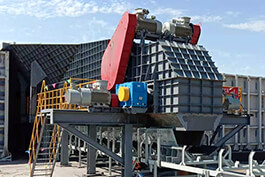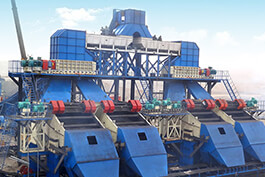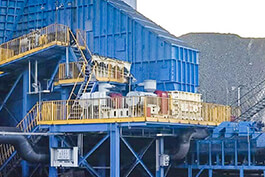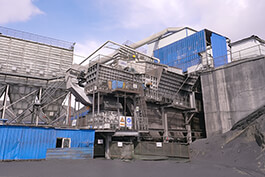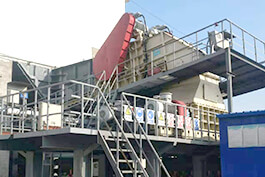Introduction
In mineral processing, selecting the appropriate mineral sizer model is critical, as it directly impacts crushing efficiency, equipment lifespan, and production operational costs. The right model can precisely match material characteristics and production requirements, while an inappropriate choice may lead to frequent equipment failures, insufficient production capacity, and other issues.
What type of material is being crushed
Each material has distinct characteristics, such as hardness, moisture content, abrasion resistance, and clay content, which directly influence sizer selection and crushing performance.
Hardness
Different materials vary significantly in hardness, with iron ore and gold ore being relatively hard, while clay and coal are softer. Hardness affects the choice of crushing method and equipment component materials.
Hard materials require strong crushing methods such as impact and compression, along with wear-resistant materials (e.g., high-manganese steel, alloy tool steel) for components to prevent rapid wear.
Soft materials can be processed using methods like shearing and stretching, which have lower requirements for material wear resistance. If equipment designed for soft materials is used to process hard materials, the equipment is prone to damage and has a short lifespan.
Conversely, using equipment designed for hard materials to process soft materials may result in over-crushing, leading to high energy consumption and low output.
Moisture Content and Viscosity
High-humidity, high-viscosity materials (such as wet clay) are prone to adhering to equipment, affecting crushing efficiency and even causing equipment blockages.
Therefore, mineral sizers must have anti-blockage designs, such as increasing the gap between the teeth rollers and optimizing the ventilation system; dry materials, however, do not require special anti-blockage designs. If equipment designed for dry materials is used to process wet, sticky materials, the equipment is prone to malfunction and reduced production capacity.
Abrasiveness
Highly abrasive materials (such as ore with high quartz content) accelerate wear and tear on equipment components. When processing such materials, equipment must be manufactured using more wear-resistant materials for components such as tooth rollers and crushing chambers, such as alloy steel with surface hardening treatment.
If abrasiveness is not taken into consideration, equipment maintenance costs will increase significantly, and frequent replacement of components will affect production efficiency and costs.
Particle Size Distribution and Shape
The original particle size and distribution of the material influence the selection of the equipment's feed opening size and crushing ratio. Larger particle sizes require a larger feed opening and appropriate crushing ratio to ensure smooth feeding and achieve the desired output particle size; smaller particle sizes have lower requirements for the feed opening.
The irregularity of material shape also affects crushing efficiency. Irregularly shaped materials may experience uneven force distribution during crushing, potentially requiring special tooth profiles or structural designs to enhance crushing efficiency and uniformity.
Model and Specifications
Different models of mineral sizers have fixed design processing capacity ranges (e.g., the primary model 2PLF800 has a processing capacity of ≤2000 t/h, while the 2PLF1500 can reach ≤10000 t/h). If the actual requirement is 5000 t/h, a model with a processing capacity within this range should be selected (e.g., 2PLF1200);
selecting a model with a smaller processing capacity (e.g., 2PLF1000, ≤3500 t/h) may result in frequent shutdowns due to overload; selecting a model with a larger processing capacity may lead to equipment idling, energy waste, and investment inefficiency.
Core Component Design
Processing capacity is directly related to core parameters such as tooth roller diameter, length, and rotational speed:
High processing capacity requirements necessitate larger tooth roller diameter and length (to increase crushing contact area) or appropriately increasing rotational speed (to increase crushing frequency per unit time);
Concurrently, the drive system (motor power, reducer load) must match production capacity to avoid “underpowered” conditions leading to insufficient power or component damage.
Production Continuity and Stability
If actual production capacity requirements approach the equipment's maximum processing capacity, fluctuations in material flow (e.g., sudden spikes in feed rate) must be considered, and a 10%-20% margin should be reserved during selection;
if processing volume is unstable (e.g., fluctuating material quantities in mining operations), models with speed adjustment functionality or overload protection (e.g., equipment with hydraulic couplers) should be chosen to avoid frequent starts/stops that disrupt production.
Supporting Systems
Processing capacity determines the specifications of upstream and downstream equipment (such as feeders and conveyors):
High-capacity mineral sizers require feeders with large conveying capacities to avoid feed bottlenecks;
Additionally, equipment installation space and foundation load-bearing capacity must be designed based on the machine size, as high-capacity models typically have larger volumes and higher site requirements.
.jpg)
Bulk Material Density
Actual Processing Capacity
The “processing capacity (t/h)” of a mineral sizer is a capacity metric based on mass, while the equipment's volumetric processing capacity (e.g., the volume of material passing through the crushing chamber per unit time) is fixed.
Different material densities result in significant mass differences for the same volume: for example, coal has a density of approximately 1.2–1.5 t/m³, while iron ore can reach 4.5–5 t/m³.
If density is ignored and selection is based solely on “volume processing capacity,” it will lead to deviations in actual mass processing capacity:
For high-density materials (such as iron ore), if selected based on the volume standards of low-density materials (such as coal), the actual mass carried by the equipment will far exceed the design value, potentially triggering overload protection shutdowns or even damaging the tooth rollers and drive system;
For low-density materials, selecting based on high-density standards will result in equipment capacity redundancy, increasing energy consumption and investment costs.
Strength of core components
High-density materials (such as metal ores) exert greater impact and compression forces on components like tooth rollers, crushing teeth, and bearings during crushing.
When processing high-density materials, it is necessary to select models with more wear-resistant tooth roller materials (such as high-strength alloy steel) and higher structural strength to prevent tooth tip fractures and roller body deformation;
The drive system (motor power, reducer torque) must also be appropriately matched — high-density materials generate greater loads during crushing, requiring motors with higher power and reducers with higher torque to ensure sufficient power.
Feeding and discharging systems
High-density materials are typically harder and have poorer flowability (e.g., wet ore), which may cause material buildup and blockages at the feed opening; low-density materials (e.g., lightweight coal blocks) have better flowability but tend to generate dust after crushing.
When selecting equipment, auxiliary design should be optimized based on density:
High-density materials: Equipped with a forced feeding device and enlarged feed opening to prevent blockages;
Low-density materials: The feeding system can be simplified, but dust prevention design (e.g., sealed covers) must be considered.
Compressive strength of the material
Crushing principles and equipment types
Materials with different compressive strengths require corresponding crushing methods:
Materials with lower compressive strength (e.g., coal, typically ≤50 MPa): Crushing can be achieved through shearing and tensile forces between the tooth rolls; standard mineral sizers (e.g., with standard tooth profiles and conventional material tooth rolls) are sufficient;
Materials with higher compressive strength (e.g., iron ore, granite, up to 100–200 MPa): require stronger compression and impact forces combined with shear action. Enhanced-design models must be selected—such as those with thick-walled tooth rollers, high-hardness alloy tooth plates (e.g., high-manganese steel or wear-resistant cast iron), or increased tooth height and density to overcome the material's resistance to crushing.
If equipment designed for low compressive strength materials is used to crush high compressive strength materials, issues such as “inability to crush” or “incomplete crushing” may arise, potentially leading to accelerated wear of the tooth rollers, drive system overload, and shutdown.
Strength and wear resistance of core components
The higher the material's compressive strength, the greater the force exerted on the equipment's core components such as tooth rollers, tooth plates, and bearings during crushing:
High compressive strength materials: Components must have higher impact resistance and wear resistance, such as tooth plates treated with surface hardening (hardness up to HRC50 or higher), and tooth roll shafts made of high-strength alloy steel (e.g., 40CrNiMo) to prevent tooth tip fractures and roll body deformation;
Low compressive strength materials: Component materials and strength can be appropriately simplified to reduce equipment manufacturing costs (e.g., tooth plates made of ordinary carbon steel with wear-resistant coatings).
Crushing efficiency and energy consumption
Compressive strength is positively correlated with the energy required for crushing:
High compressive strength materials: The crushing process consumes more energy, so larger-power motors and higher-torque transmission systems (such as reducers and couplings) must be selected to ensure sufficient output power; insufficient power can cause a sharp drop in crushing efficiency and even frequent jamming.
Low compressive strength materials: require less power; using high-power equipment will result in energy waste and increased operating costs.
Conclusion
When selecting the appropriate mineral sizer model, it is essential to comprehensively consider factors such as material type (hardness, moisture content, abrasiveness, etc.), processing capacity, bulk material density, and material compressive strength. Only by precisely matching the equipment with material characteristics and production requirements can crushing efficiency be ensured, equipment wear reduced, operational costs controlled, and the full potential of the mineral sizer in mineral processing be realized. When selecting a model, actual production data and equipment parameters should be considered, and testing should be conducted when necessary to make the optimal choice.


.jpg)
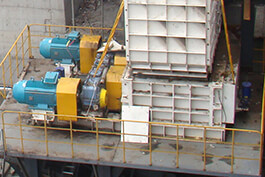
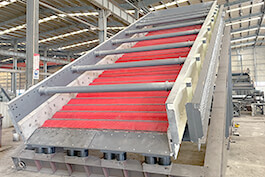
.jpg)
